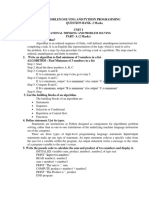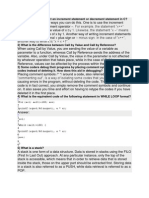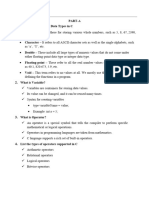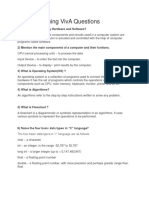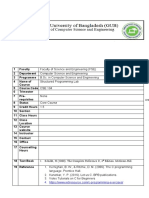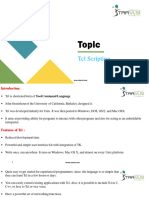02 Programming Languages Overview
Uploaded by
taonanyasha shoriwa02 Programming Languages Overview
Uploaded by
taonanyasha shoriwaIntroduction to
Computer
Programming
2021
Things don’t happen automatically within a computer. Whatever a
computer does, whether it seems automatically or not, originates
from instructions given to that computer by someone.
Tinashe Mutandagayi | COMPUTER PROGRAMMING COMPLEMENTARY MANUAL 2021
Pg. 01 Programming Languages Overview
Programming Languages Overview
A computer program consists of code and data. Data can be represented using different data
types. Code can be classified into functions and modules.
Data
Data is simply unprocessed or raw facts. Information is processed facts.
Instructions
An instruction is an action which the computer can perform. When a computer receives a
particular instruction, it carries out that instruction in a certain, specific and predetermined way.
Functions
Sometimes, a certain set of instructions may need to be issued to a computer more than once,
for any kinds of reasons and purposes. Whatever the case, these instructions can be grouped
and discretely identified for later use.
A function is a collection of reusable instructions (code) that is given a name to identify it.
Anytime that collection of instructions (function) needs to be used, it is invoked or called using
its name.
Some functions work with extra information, also known as arguments or parameters. These
are passed to the function when it is invoked (if needed). For example, if a function is created
to add 2 numbers. Definitely, that function will need to know what the 2 numbers are.
Additionally, when a function completes its execution (depending on what the function does),
it gives back information or results. For example, if a function which adds 2 number is called,
arguments are passed as it is invoked. When that function completes its task, it is expected to
give back the result of its operation, i.e the sum of the 2 numbers.
Tinashe Mutandagayi | COMPUTER PROGRAMMING COMPLEMENTARY MANUAL 2021
Pg. 02 Programming Languages Overview
A function which does not return results after executing is called a sub-routine in Visual Basic
and is defined using the Sub keyword. Such a function is called a void function in C# and other
C-like languages.
A function which returns results after executing is called a function in BASIC and is defined
using the Function keyword. Such a function is simply a non-void function in C# and other C-
like languages.
Identifiers
An identifier is a name given to data or to a function or other named entities within a
programming language.
Data can be given a name to make it easy to reuse the data and to reference it in future.
Functions can also be given names for reuse.
Identifiers can be classified into variables and constants. A variable is data that can/might
change its value anytime. An example of a variable is a person’s age which changes every year
or time which changes in fractions of a second. On the other hand, a constant is data that will
not change at any time. An example of a constant is a person’s birthday, or the year a certain
country got independence because it never changes.
Data Types
Data is classified into many types. Each type has to be chosen according to the purpose. Here is
a list of the primitive data types supported in Visual Basic and C#
Boolean
A Boolean data type holds a value of true or false.
Integer
An integer data type holds whole numbers only, either positive or negative
Floating Point
Tinashe Mutandagayi | COMPUTER PROGRAMMING COMPLEMENTARY MANUAL 2021
Pg. 03 Programming Languages Overview
Floating point data types hold numbers that have fractions or a decimal point. The term
floating point is used to indicate that the values contained in floating point numbers are
actually an approximation of the real value.
For example 1/3 = 0.3333333333, in other words 1 divided by 3 is 0.3333333333. But if we are
to say 0.3333333333 x 3, we will get 0.9999999999 instead of 1.
Characters
Remember that a computer only understands numbers, so how is it possible to represent
characters like those in the alphabet on a computer.
To overcome this challenge, engineers agreed to assign a specific number to each character so
that characters like the alphabet can be represented. The computer will process them as
numbers but they will be interpreted as characters.
One of the most common character mapping used on computers is the ASCII standard
mapping.
Characters can be grouped to represent sentences, paragraphs or even books. A group of
characters is called a string.
String
A string is a group (sequence) of characters in series. A string can be used to hold a sequence
of characters, a word, a sentence, paragraph and so on.
Literals
Data can be represented in many ways inside a computer program. Data can be represented by
an identifier which is either a constant or a variable. An example is
name which is a variable that might contain a string like “Alexander”
age which is a variable that might contain a value like 29
Tinashe Mutandagayi | COMPUTER PROGRAMMING COMPLEMENTARY MANUAL 2021
Pg. 04 Programming Languages Overview
Data can also be represented using literals. A literal is a value that should be interpreted as it is.
Instead of using names like above, a computer program can represent data directly by value
like this:
“Alexander”
19
When the compiler finds characters inside double quotes, it infers that the data type is a string
and treats it as it is. In-order to denote a variable named Alexander, the variable must be stated
without the quotes.
When a compiler finds the value 19, it just interprets it as it is, literally.
Control Flow
Flow Control
The flow of a program is the order in which statements or instructions of that program are
executed. Normally programs are executed from top to bottom in the order in which they are
written. Some instructions or statements can be used to alter this order. This can be for various
reasons listed below:
Iterative statements
Iterative statements are used to execute a group of instructions multiple times. This maybe for
various reasons. A group of instructions which can be executed multiple times is called a loop
There are 2 types of iterative statements, bounded and unbounded loops.
Bounded Loops
Bounded loops are executed repetitively in a predictable way. An example is a loop which
should repeat 5 times, is predictable in that the amount of time that loop will run can be
calculated in advance. The for-loop is used for a loop that runs a specific number of times.
Tinashe Mutandagayi | COMPUTER PROGRAMMING COMPLEMENTARY MANUAL 2021
Pg. 05 Programming Languages Overview
In BASIC the for loop has the following format:
For <counter> = <start> To <end> [Step <number>]
statements
Next
In C# the for loop has the following format:
for (initial_assignment ; predicate ; incremental_routine){
statements
The for-loop repeats a group of statements within its scope. A start value and end value are
required to use the for loop. This range of values tells the computer to count from the start
value to end value. counter is the variable which will contain the current value of the iteration.
The first value given to the counter variable is start. Then the computer either increases or
decreases the value in counter by 1 until counter is equal to end. When counter is equal to
end, then the loop terminates.
An example in BASIC is as follows:
Dim i As Integer
For i = 1 To 100
Console.Write(“Iteration ”)
Console.WriteLine(i)
Next
A C# example is as follows:
int i;
For (i = 1 ; i < 100; i++) {
Console.Write(“Iteration ”);
Console.WriteLine(i);
}
Tinashe Mutandagayi | COMPUTER PROGRAMMING COMPLEMENTARY MANUAL 2021
Pg. 06 Programming Languages Overview
The previous block of code will cause the statement to be printed 100 times. The print
statement will cause the Console to display messages as follows:
Iteration 1
Iteration 2
Iteration 3
Iteration 4
Iteration 99
Iteration 100
Infinite Loop
An infinite loop is a loop which runs endlessly. This happens because the given condition will
never be met
Unbounded Loop
An unbounded loop is a loop that has no predictable lifespan. A for-loop can be predicted
because it only runs a specific number of times. There are other loops that do not have a fixed
set of values within which to iterate. The while-loop is used to implement unbounded loops.
The while loop tells a computer to repeat a group of statements until a certain condition is met,
or while a certain condition is true. The reason why such loops are unbounded and therefore
unpredictable is that, there is no way to know when that condition will be met. For example,
When a computer program is waiting until it gets an internet connection, it may wait for
seconds, or minutes, hours or even days or weeks. There is no telling when the internet will be
Tinashe Mutandagayi | COMPUTER PROGRAMMING COMPLEMENTARY MANUAL 2021
Pg. 07 Programming Languages Overview
connected. Therefore such loops are unpredictable, because it could be a service provider
problem, subscription issue or weather.
Dim wrongPassword As Boolean = True
While wrongPassword
Console.Write(“Enter a valid password. ”)
Dim password = Console.ReadLine()
If (password = “valid”) Then
wrongPassword = False
Else
Console.WriteLine(“You entered an invalid password”)
End If
End While
Conditional Statements
Conditional statements are used to control when a certain block of instructions should be
executed. This allows decisions to be made before a computer can take certain actions. An
example might be, the computer must show the documents and files only when a user is
logged in, to prevent unauthorised access. This would mean, for a user who hasn’t logged, the
computer system would show a login screen asking for a password, but if the user is logged in,
he/she is given access to documents.
The If-statement is used to implement conditional execution of a group of statements. When
the specified condition is True, then the following block is executed. If the condition is not True,
then other conditions in ElseIf blocks are executed. If all conditions either from the If or
ElseIf are not True, then the Else block is executed. The ElseIf and Else blocks are optional
Visual BASIC
If condition [ Then ]
[ statements ]
[ ElseIf elseifcondition [ Then ]
[ elseifstatements ] ]
[ Else
[ elsestatements ] ]
End If
Tinashe Mutandagayi | COMPUTER PROGRAMMING COMPLEMENTARY MANUAL 2021
Pg. 08 Programming Languages Overview
The If-statement can also be written in a single line like this:
If condition Then [ statements ] [ Else [ elsestatements ]
C#
if (condition) {
[ statements ]
}
[ else if (elseifcondition) {
[ elseifstatements ] ]
}
else {
[ elsestatements ] ]
}
Procedures
A procedure is a reusable group of instructions which can be separately identified and invoked.
A procedure is written once but can be invoked many times. It is used to identify and manage
code blocks that occur many times within a program.
The advantage of procedures is that they avoid repetition, and therefore minimize errors. If a
block of code contains errors, but that block of code is repeated throughout the program, it is
difficult to completely correct the error, and the error will have to be corrected in many places.
A procedure on the other hand allows a code block to be written once and used many times.
Any correction in that block of code only happens.
Procedures also make it easy to separate and identify code blocks that perform different tasks.
This makes source code readable and easy to modify or manage.
There are 2 kinds of procedures in BASIC. The first type is called a sub-routine and the
second one is called a Function.
A sub-routine is a procedure that only performs a task, but does not have to give back a
response. It simply carries out a straightforward operation without giving feedback.
A Function gives back results after executing.
A sub-routine is defined using the Sub keyword as follows
Tinashe Mutandagayi | COMPUTER PROGRAMMING COMPLEMENTARY MANUAL 2021
Pg. 09 Programming Languages Overview
Sub SubName[(parameterList)]
' Statements of the Sub procedure.
End Sub
parameterList is a list of variables that can be sent to the subroutine. This is normally
additional information. For example. Console.WriteLine is a sub-routine. This sub-routine
accepts a string so that it prints that string. That is why we write it as
Console.WriteLine(“Hello World”)
A function is defined using the Function keyword as follows:
Function FunctionName [(ParameterList)] As ReturnType
[Statements]
End Function
A function unlike a sub-routine also has a ReturnType. This is the data-type of the results after
the function executes. Let us say the function adds 2 integers to produce another integer. The
resulting integer is returned after the function therefore the function’s ReturnType is integer.
Tinashe Mutandagayi | COMPUTER PROGRAMMING COMPLEMENTARY MANUAL 2021
You might also like
- Hourglass Workout Program by Luisagiuliet 276% (21)Hourglass Workout Program by Luisagiuliet 251 pages
- The Hold Me Tight Workbook - Dr. Sue Johnson100% (16)The Hold Me Tight Workbook - Dr. Sue Johnson187 pages
- Read People Like A Book by Patrick King-Edited62% (66)Read People Like A Book by Patrick King-Edited12 pages
- Livingood, Blake - Livingood Daily Your 21-Day Guide To Experience Real Health77% (13)Livingood, Blake - Livingood Daily Your 21-Day Guide To Experience Real Health260 pages
- COSMIC CONSCIOUSNESS OF HUMANITY - PROBLEMS OF NEW COSMOGONY (V.P.Kaznacheev,. Л. V. Trofimov.)94% (212)COSMIC CONSCIOUSNESS OF HUMANITY - PROBLEMS OF NEW COSMOGONY (V.P.Kaznacheev,. Л. V. Trofimov.)212 pages
- Donald Trump & Jeffrey Epstein Rape Lawsuit and Affidavits83% (1016)Donald Trump & Jeffrey Epstein Rape Lawsuit and Affidavits13 pages
- The 36 Questions That Lead To Love - The New York Times94% (34)The 36 Questions That Lead To Love - The New York Times3 pages
- The 36 Questions That Lead To Love - The New York Times95% (21)The 36 Questions That Lead To Love - The New York Times3 pages
- Jeffrey Epstein39s Little Black Book Unredacted PDF75% (12)Jeffrey Epstein39s Little Black Book Unredacted PDF95 pages
- The 4 Hour Workweek, Expanded and Updated by Timothy Ferriss - Excerpt23% (954)The 4 Hour Workweek, Expanded and Updated by Timothy Ferriss - Excerpt38 pages
- OCA Java Programmer 8 Fundamentals 1Z0-808100% (1)OCA Java Programmer 8 Fundamentals 1Z0-808419 pages
- Programming Paradigms: A Must Know For All ProgrammersNo ratings yetProgramming Paradigms: A Must Know For All Programmers4 pages
- Problem Analysis Decision Tree Table Pseudocode AlgorithmNo ratings yetProblem Analysis Decision Tree Table Pseudocode Algorithm9 pages
- 2-Introduction to Structured Programming - C language History and Introduction - Datatypes-Basic IO statements - Variables - Keywords - Expression evaluation using operator precedence-17-12-2024No ratings yet2-Introduction to Structured Programming - C language History and Introduction - Datatypes-Basic IO statements - Variables - Keywords - Expression evaluation using operator precedence-17-12-202442 pages
- Capes Notes Objective #7: Explain The Concept of Algorithm: Properties IncludingNo ratings yetCapes Notes Objective #7: Explain The Concept of Algorithm: Properties Including4 pages
- Day3-Facilitation Guide (Programming Statements)No ratings yetDay3-Facilitation Guide (Programming Statements)9 pages
- GE3151 Problem Solving and Python Programming Two Mark Questions 1No ratings yetGE3151 Problem Solving and Python Programming Two Mark Questions 125 pages
- C Viva Hghkgaldghldkhgkdlgd DFJDSJFLSJFLSDFLDSKJFKDSFSJFLSJF FJFKJSF DSFDSFKSJFDKSJFKLDSJFNo ratings yetC Viva Hghkgaldghldkhgkdlgd DFJDSJFLSJFLSDFLDSKJFKDSFSJFLSJF FJFKJSF DSFDSFKSJFDKSJFKLDSJF15 pages
- Top 100 + C Programming Interview Questions & AnswersNo ratings yetTop 100 + C Programming Interview Questions & Answers23 pages
- Algorithmandpseudocodes 120630115656 Phpapp02No ratings yetAlgorithmandpseudocodes 120630115656 Phpapp0244 pages
- For (A 1 A< 100 A++) Printf (" %d/n", A A)No ratings yetFor (A 1 A< 100 A++) Printf (" %d/n", A A)12 pages
- BABI Feb'19 Prep - Programming Basics - v1-1No ratings yetBABI Feb'19 Prep - Programming Basics - v1-14 pages
- Lab 07: Functions: National University of TechnologyNo ratings yetLab 07: Functions: National University of Technology8 pages
- Algorithmandpseudocodes 120630115656 Phpapp02No ratings yetAlgorithmandpseudocodes 120630115656 Phpapp0244 pages
- Coding for beginners The basic syntax and structure of codingFrom EverandCoding for beginners The basic syntax and structure of codingNo ratings yet
- 3BSE044222-610 A en Compact Control Builder AC 800M - PlanningNo ratings yet3BSE044222-610 A en Compact Control Builder AC 800M - Planning174 pages
- Nims Group of School, Uae Grade: 6 CBSE Subject: Information TechnologyNo ratings yetNims Group of School, Uae Grade: 6 CBSE Subject: Information Technology5 pages
- Competency in Process Control - Industry Guidelines: 1.0 Competitive Marketplace BackgroundNo ratings yetCompetency in Process Control - Industry Guidelines: 1.0 Competitive Marketplace Background8 pages
- Mehlhorn K., Sanders P. Concise Algorithmics, The Basic Toolbox 124ñ PDFNo ratings yetMehlhorn K., Sanders P. Concise Algorithmics, The Basic Toolbox 124ñ PDF124 pages
- Chapter 7 - A Closer Look On Methods and ClassesNo ratings yetChapter 7 - A Closer Look On Methods and Classes26 pages
- UiPath Certified RPA Associate v1.0 - EXAM DescriptionNo ratings yetUiPath Certified RPA Associate v1.0 - EXAM Description6 pages
- Livingood, Blake - Livingood Daily Your 21-Day Guide To Experience Real HealthLivingood, Blake - Livingood Daily Your 21-Day Guide To Experience Real Health
- COSMIC CONSCIOUSNESS OF HUMANITY - PROBLEMS OF NEW COSMOGONY (V.P.Kaznacheev,. Л. V. Trofimov.)COSMIC CONSCIOUSNESS OF HUMANITY - PROBLEMS OF NEW COSMOGONY (V.P.Kaznacheev,. Л. V. Trofimov.)
- Donald Trump & Jeffrey Epstein Rape Lawsuit and AffidavitsDonald Trump & Jeffrey Epstein Rape Lawsuit and Affidavits
- The 36 Questions That Lead To Love - The New York TimesThe 36 Questions That Lead To Love - The New York Times
- The 36 Questions That Lead To Love - The New York TimesThe 36 Questions That Lead To Love - The New York Times
- Jeffrey Epstein39s Little Black Book Unredacted PDFJeffrey Epstein39s Little Black Book Unredacted PDF
- The 4 Hour Workweek, Expanded and Updated by Timothy Ferriss - ExcerptThe 4 Hour Workweek, Expanded and Updated by Timothy Ferriss - Excerpt
- Programming Paradigms: A Must Know For All ProgrammersProgramming Paradigms: A Must Know For All Programmers
- Problem Analysis Decision Tree Table Pseudocode AlgorithmProblem Analysis Decision Tree Table Pseudocode Algorithm
- 2-Introduction to Structured Programming - C language History and Introduction - Datatypes-Basic IO statements - Variables - Keywords - Expression evaluation using operator precedence-17-12-20242-Introduction to Structured Programming - C language History and Introduction - Datatypes-Basic IO statements - Variables - Keywords - Expression evaluation using operator precedence-17-12-2024
- Capes Notes Objective #7: Explain The Concept of Algorithm: Properties IncludingCapes Notes Objective #7: Explain The Concept of Algorithm: Properties Including
- GE3151 Problem Solving and Python Programming Two Mark Questions 1GE3151 Problem Solving and Python Programming Two Mark Questions 1
- C Viva Hghkgaldghldkhgkdlgd DFJDSJFLSJFLSDFLDSKJFKDSFSJFLSJF FJFKJSF DSFDSFKSJFDKSJFKLDSJFC Viva Hghkgaldghldkhgkdlgd DFJDSJFLSJFLSDFLDSKJFKDSFSJFLSJF FJFKJSF DSFDSFKSJFDKSJFKLDSJF
- Top 100 + C Programming Interview Questions & AnswersTop 100 + C Programming Interview Questions & Answers
- For (A 1 A< 100 A++) Printf (" %d/n", A A)For (A 1 A< 100 A++) Printf (" %d/n", A A)
- Lab 07: Functions: National University of TechnologyLab 07: Functions: National University of Technology
- "C Programming for Beginners: A Step-by-Step Guide"From Everand"C Programming for Beginners: A Step-by-Step Guide"
- Coding for beginners The basic syntax and structure of codingFrom EverandCoding for beginners The basic syntax and structure of coding
- 3BSE044222-610 A en Compact Control Builder AC 800M - Planning3BSE044222-610 A en Compact Control Builder AC 800M - Planning
- Nims Group of School, Uae Grade: 6 CBSE Subject: Information TechnologyNims Group of School, Uae Grade: 6 CBSE Subject: Information Technology
- Competency in Process Control - Industry Guidelines: 1.0 Competitive Marketplace BackgroundCompetency in Process Control - Industry Guidelines: 1.0 Competitive Marketplace Background
- Mehlhorn K., Sanders P. Concise Algorithmics, The Basic Toolbox 124ñ PDFMehlhorn K., Sanders P. Concise Algorithmics, The Basic Toolbox 124ñ PDF
- UiPath Certified RPA Associate v1.0 - EXAM DescriptionUiPath Certified RPA Associate v1.0 - EXAM Description







































